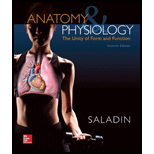
Introduction:
An autonomous nervous system is one in which that innervates the vital organs and body parts to enable it to function without the commanding of host personal interest. Most of the vital processes of
Answer to Problem 1TYR
Correct answer:
Skeletal muscle is the only tissue part out of the following, which is not innervated by the autonomic nervous system. Therefore option b is correct.
Explanation of Solution
Justify reasons for the correct statement:
Skeletal muscles make a predominant muscular part of an individual physic. These muscles are well connected to the bones so called as tendons. A collagen fiber brings this attachment of muscles with bones. These skeletal muscles are innervated by the somatic nervous system or voluntary nervous system. Action of these muscle systems are highly controlled by the individuals’ personal interest like during exercise, dance, and writing. Skeletal muscles are under the control of individual orders and consciousness. A person’s day-to-day activities by his physic is brought under voluntary skeletal muscle actions.
Option (b) is given as “skeletal muscle”.
Skeletal muscle is the only muscle tissue not innervated by the autonomous nervous system.
Hence, Option (b) is correct
Justify reasons for the incorrect statements:
Option (a) is given as “cardiac muscle”
Cardiac muscles that constitute the heart beat contraction and expansions to pump blood are not controlled by individual’s voluntary action, but it is under involuntary nervous system.
Option (c) is given as “smooth muscle”
Smooth muscles that form the digestive and urinary bladder tissues responsible for contraction and relaxation of muscle tissues during excretion and digestion of food materials are by involuntary nervous actions.
Option (d) is given as “salivary gland”
Salivary glands to secrete saliva by the taste and sight of food by visual perception are involuntary nervous coordination.
Option (e) is given as “blood vessels”
Constriction and dilation of blood vessels with the help of squamous epithelium during low and increased blood pressure are due to involuntary nervous system. It also coordinates the voluntary system of the body.
Hence, options (a), (c), (d), and (e) are incorrect.
Thus, the skeletal muscle is the only tissue part that is not innervated by involuntary nervous system, and it is controlled by voluntary nervous system.
Want to see more full solutions like this?
Chapter 15 Solutions
Anatomy and Physiology - With Lab. Manual
- All of the following are true concerning reflex arcs EXCEPT A.they involve a few neurons and directly enter and immediately leave the spinal cord B.they are used to prevent harm C.they are subconscious and automatic D.they only use the PNS and not the CNSarrow_forwardYou stick your tongue out to make your friend laugh. The structure of the brain that controls this movement, and the division of the nervous system it is part of, respectively are: Select one: a. the cerebrum and the autonomic nervous system b. the cerebrum and the somatic nervous system c. the medulla oblongota and the autonomic nervous system d. the medulla oblongota and the somatic nervous systemarrow_forwardWhich of the following brain regions is not correctly matched to itsfunction?a. The medulla oblongata regulates heartbeat, breathing, and bloodpressure.b. The cerebellum coordinates voluntary muscle movements.c. The thalamus secretes melatonin, which regulates daily bodyrhythms.d. The midbrain acts as a refl ex center for visual, auditory, andtactile responses.arrow_forward
- Sympathetic nerve stimulation does not causea. the liver to release glycogen.b. the dilation of bronchioles.c. the gastrointestinal tract to digest food.d. an increase in the heart rate.arrow_forwardwhich of the following does not describe the somatic nervous system? A. motor neurons that innervate glands, cardiac and skeletal muscle B. a system of motor neurons that innervate all muscle cells c. voluntary nervous system d. general sensory for skin and joints.arrow_forwardThe autonomic system has two divisions, called thea. CNS and PNS.b. somatic and skeletal systems.c. efferent and afferent systems.d. sympathetic and parasympathetic divisionsarrow_forward
- Select the statement that best describes the local circuitry of the spinal cord. a. There is no local circuitry within the spinal cord. b. Local circuits enable the same neurons to innervate both distal and proximal muscles. c. Neurons that innervate distal muscles are interconnected across the midline. d. None of the answers. e. Neurons that innervate proximal muscles are interconnected through many spiral cord segments.arrow_forwardWhich of these tracts carries motor signals destined for the postural muscles? a. the gracile fasciculus b. the cuneate fasciculus c. the spinothalamic tract d. the vestibulospinal tract e. the tectospinal tractarrow_forwardThe subdivision of the brain that does not initiate somatic motor movements, but rather coordinates and fine-tunes those movements, is the a. medulla oblongata. b. cerebrum. c. cerebellum. d. diencephalon.arrow_forward
- Which of the following cranial nerves carries sympathetic fibers? a. oculomotor b. facial c. trigeminal d. vagus e. none of the cranial nervesarrow_forwardThe thoracic spinal cord has the smallest dorsal horn area because: a. the trunk is the most innervated area of the body and therefore there are more projections into the dorsal horn there. b. the trunk is the least innervated area of the body and therefore there are fewer projections into the dorsal horn there. c. most of the descending upper motor neurons have already entered the ventral horn. d. There are many motor neurons to control the small muscles around the spine.arrow_forwardWhich of the following is correct regarding the autonomic nervoussystem?a. It uses both cranial and spinal nerves.b. It is divided into sympathetic and parasympathetic divisions.c. Most organs under ANS control are under dual innervation—thatis, by both sympathetic and parasympathetic divisions.d. Major responsibilities are regulation and repair of cardiacmuscle, smooth muscle, organs, and glands.e. All of these are correct.arrow_forward
 Concepts of BiologyBiologyISBN:9781938168116Author:Samantha Fowler, Rebecca Roush, James WisePublisher:OpenStax College
Concepts of BiologyBiologyISBN:9781938168116Author:Samantha Fowler, Rebecca Roush, James WisePublisher:OpenStax College

